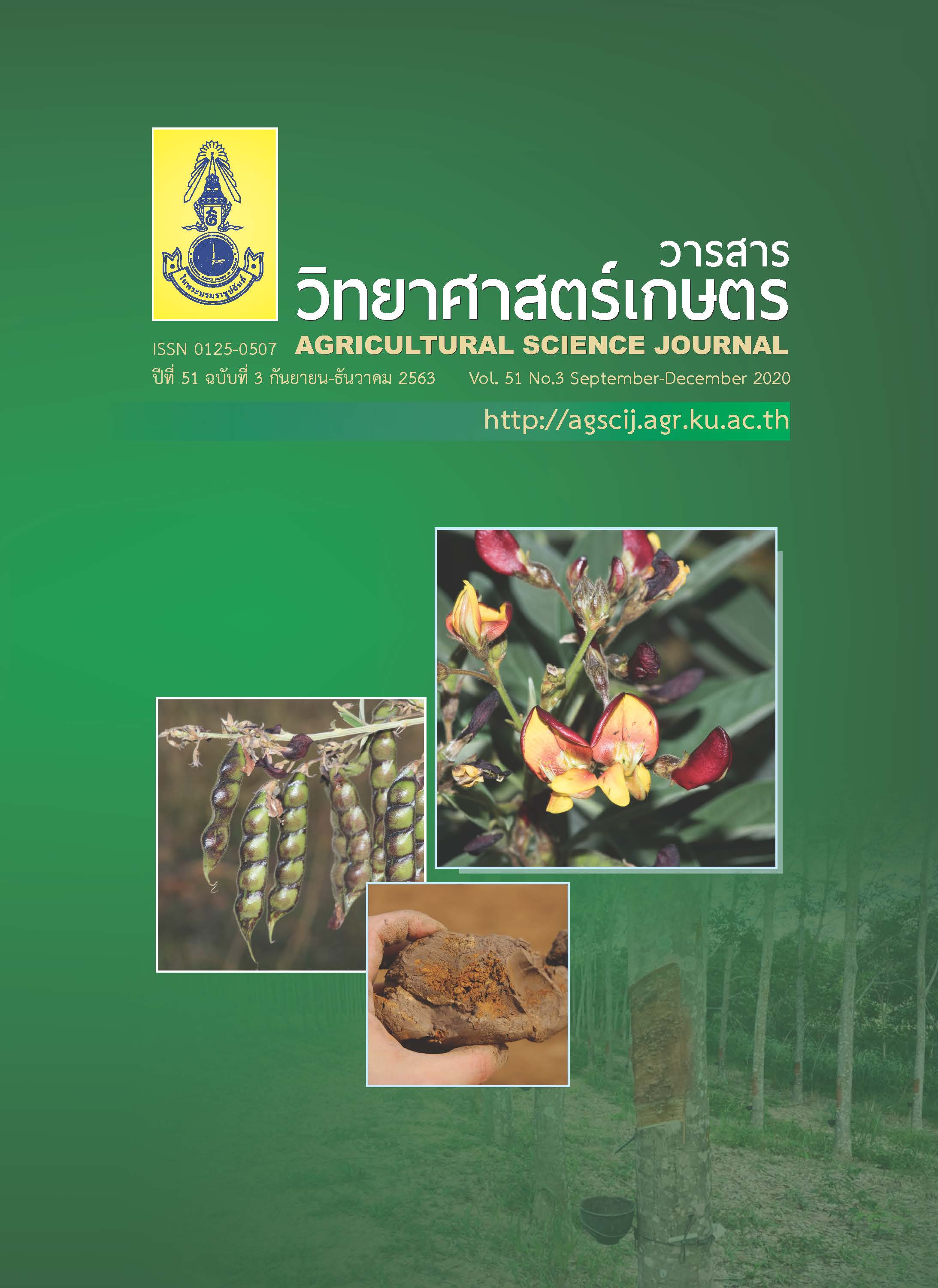ความแปรปรวนทางสัณฐานวิทยาและลักษณะทางการเกษตรของถั่วมะแฮะพื้นเมืองสายพันธุ์ T9
Main Article Content
บทคัดย่อ
ถั่วมะแฮะพื้นเมืองสายพันธุ์ T9 ที่รวบรวมจากพื้นที่ในจังหวัดอุตรดิตถ์ ถูกนำมาใช้ในการประเมินความแปรปรวนทางสัณฐานวิทยาและลักษณะทางการเกษตร โดยปลูกทดสอบที่สถานีวิจัยลำตะคอง จังหวัดนครราชสีมา สำหรับเป็นแหล่งพันธุกรรมในการคัดเลือกพันธุ์ถั่วมะแฮะให้มีปริมาณโปรตีนสูง เพื่อใช้เป็นแหล่งโปรตีนทางเลือกสำหรับอุตสาหกรรมอาหาร วางแผนการทดลองแบบสุ่มสมบูรณ์ (Completely randomized design) สุ่มเก็บข้อมูลทางสัณฐานวิทยา และการให้ผลผลิต (16 ลักษณะ) ของถั่วมะแฮะสายพันธุ์ T9 จาก 98 accessions (จำนวน 3 ซ้ำ) จากทั้งหมด 393 accessions วิเคราะห์การจัดกลุ่มด้วยวิธี UPGMA (Unweighted pair–group method with arithmetic average) โดยใช้ค่า Euclidean distance และตรวจสอบรูปแบบการกระจายตัวของถั่วมะแฮะ ด้วยวิธี Principal component analysis ผลการศึกษา พบว่า ค่าสัมประสิทธิ์ความต่างอยู่ในช่วง 1.00–25.00 สามารถแบ่งกลุ่มถั่วมะแฮะสายพันธุ์ T9 ออกเป็น 2 กลุ่มหลัก คือ กลุ่มที่ 1 จำนวน 81 accessions ซึ่งสามารถแบ่งออกเป็น 2 กลุ่มย่อย คือ กลุ่มย่อยที่ 1.1 จำนวน 33 accessions และกลุ่มย่อย ที่ 1.2 จำนวน 48 accessions และกลุ่มที่ 2 จำนวน 17 accessions ซึ่งสามารถแบ่งออกเป็น 2 กลุ่มย่อย คือ กลุ่มย่อยที่ 2.1 จำนวน 16 accessions และกลุ่มย่อยที่ 2.2 จำนวน 1 accession ถั่วมะแฮะในกลุ่มที่ 2 เหมาะสำหรับนำไปใช้เป็นแหล่งพันธุกรรมสำหรับการคัดเลือกพันธุ์และการปรับปรุงพันธุ์ถั่วมะแฮะ
Article Details
เอกสารอ้างอิง
Ayenan, M.A.T., K. Ofori, L.E. Ahoton and A. Danquah. 2017. Pigeonpea [(Cajanus cajan (L.) Millsp.)] production system, farmers’ preferred traits and implications for variety development and introduction in Benin. Agric. Food Secur. 6: 48.
Bishnoi, S.K., R.S. Rathi, S.B. Choudhary, P.K. Malav and S.P. Ahlawat. 2019. Phenotypic characterization of Pigeonpea (Cajanus cajan) germplasm collected from Jharkhand, India. Indian J. Plant Genet. Resour. 32(3): 354−359.
Choudhary, A.K. 2011. Effects of pollination control in pigeonpea and their implication. Journal of Food Legumes. 24(1): 50−53.
Department of Agriculture. 2020. Pigeon pea. Available Source: https://www.doa.go.th/cv/view.php?id=204, December 20, 2020.
Jolliffe, I.T. 2002. Principal Component Analysis. 2nd edition. Springer–Verlag New York, Inc., New York, USA. 500 pp.
Kaewkunya, C., P. Pasartchai and A. Oupaphong. 2012. The potential of tropical legumes for provide good quality forage and lateritic soil improvement. Agricultural Sci. J. 43(Suppl. 2): 585–588. (in Thai)
Karri, V.R. and N. Nalluri. 2017. Pigeon pea (Cajanus cajan L.) by–products as potent natural resource to produce protein rich edible food products. IJCAS. 7(7): 229−236.
Kasikorn Research Center. 2019. Plant–based protein. Available Source: https://kasikornresearch.com/th/analysis/k–social–media/Pages/20190604_00.aspx, June 4, 2019.
Saxena, K.B. and S.L. Sawargaonkar. 2015. Genetic enhancement of seed proteins in pigeonpeamethodologies, accomplishments, and opportunities. Int. J. Sci. Res. 4(5): 3–7.
Saxena, K.B., R. Sultana, P. Bhatnagar–Mathur, R.K. Saxena, Y.S. Chauhan, R.V. Kumar, I.P. Singh, R.S. Raje and A.N. Tikle. 2016. Accomplishments and challenges of pigeonpea breeding research in India. Indian J. Genet. 76(4): 467–482.
Sheahan, C.M. 2012. Plant Guide for Pigeon Pea (Cajanus cajan). USDA–Natural Resources Conservation Service, Cape May Plant Materials Center, Cape May, New Jersey, USA.
Sneath, P.H.A. and R.R. Sokal. 1973. Numerical Taxonomy: The Principles and Practice of Numerical Classification. 1st edition. W.H. Freeman, San Francisco, USA. 573 pp.
Sokal, R.R. and C.D. Michener. 1958. A statistical method for evaluating systematic relationships. Univ. Kans. Sci. Bull. 38: 1409–1448.
Teli, S.B., K.V. Patel and D.J. Parmar. 2019. Genetic diversity analysis in pigeonpea (Cajanus cajan (L.) Millsp.). J. Pharmacogn. Phytochem. 8(6): 101–103.
Upadhyaya, H.D., K.N. Reddy, C.L.L. Gowda and S. Singh. 2007. Phenotypic diversity in the pigeonpea (Cajanus cajan) core collection. Genet. Resour. Crop Evol. 54: 1167–1184.
Upadhyaya, H.D., K.N. Reddy, S. Sharma, R.K. Varshney, R. Bhattacharjee, S. Singh and C.L.L. Gowda. 2011. Pigeonpea composite collection and identification of germplasm for use in crop improvement programs. Plant Genet. Resour. 9(1): 97–108.
Wanjari, K.B., R.S. Raje, K. Durgesh, G.R. Prashat and R. Joshi. 2016. Pigeonpea improvement through conventional breeding. Indian J. Genet. 76(4): 483−495.
Yohane, E.N., H. Shimelis, M. Laing, I. Mathew and A. Shayanowako. 2020. Phenotypic divergence analysis in Pigeonpea [Cajanus cajan (L.) Millspaugh] germplasm accessions. Agronomy. 10: 1682.


